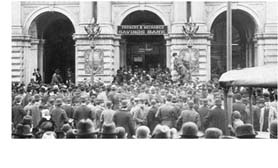Start of Depression 1800´s
Farmers and debtors, feeling a the economic downturn of the united states depression and began requesting the halt of the greenback notes. Around 1867, the wartime economic boom had ended and it was in their interest to create inflation, which would make it easier for them to pay off large debts.
A compromise was reached in which $356 million worth of greenbacks would remain in circulation. Neither side was fully in agreement with this result.
The financial uprising of 1873 started in the fall and was followed by the worst united states depression in history up to that time, climaxing in 1893. The monetary issue was revived and was argued heatedly by both sides. During the united states depression, president Grant was originally sympathetic to the farmers’ plight, but he eventually caved in to the wishes of his wealthy friends and vetoed a measure that would have expanded the greenback currency.
The conservaties won an important victory in the passage of the famous Resumption Act of 1875. This law provided that on January 1, 1879, all greenbacks would be redeemable at full face value. Debtor groups immediately began working for the law’s repeal, a movement that developed into the National Greenback Party. However, due to the united states depression, the general population, was well as the Congress, was nearly equally divided on monetary issues. Therefore, in 1878 a compromise was worked out which provided that:
The Resumption Act would was not repealed as many farmers and the general public wished
The currency supply would be slightly increased through the printing of more greenbacks of additional gold & silver backed currency A limited coinage of silver dollars would be allowed through the Bland-Allison Act (1878), a small inflationary gesture to the debtor interests. The united states depression lasted a long time but the economy improved.




